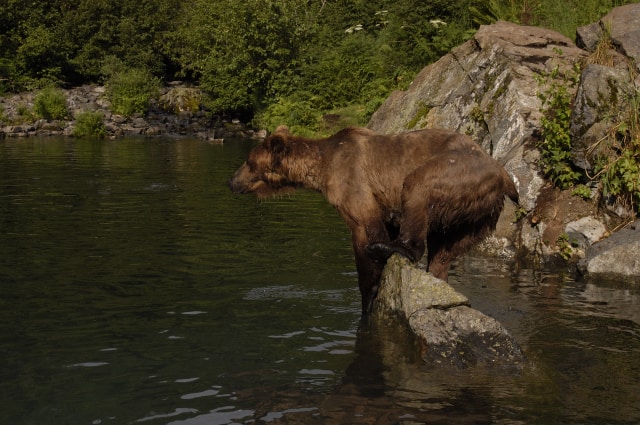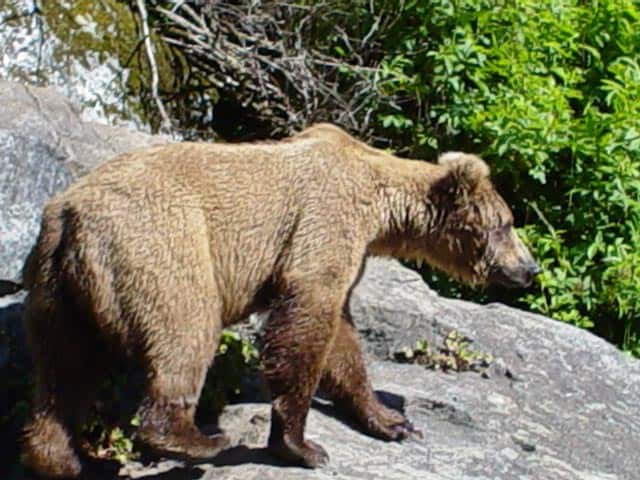
26 Jan Alaska Fly Out: Wolverine Creek
Fly-out fantastic!…
Up close and personal with the Brown Bears of Wolverine Creek: Big River Lake, West Side Cook Inlet
 “When the pilot said we’d see bears, I did not think they’d be five feet from the boat.” This is a typical reaction after visiting Big River Lake and the rocky mouth of Wolverine Creek.
“When the pilot said we’d see bears, I did not think they’d be five feet from the boat.” This is a typical reaction after visiting Big River Lake and the rocky mouth of Wolverine Creek.
Located just 20 minutes from Kenai by float plane, this glacially turbid lake is nestled into the side of a coastal mountain, on the West Side of Cook Inlet. Its waters are half blue and half brown. The blue portion of the lake represents clean feeder streams of rocky, mountainous origins, like Wolverine Creek. The murky, brown water comes directly from grinding glaciers, with no lakes or clean flows to filter its path. The line where the two sources meet is obvious from the water and stunning from the air.
With increasing frequency, float planes depart from Kenai Peninsula Lakes ferrying anglers to remote fishing waters. Big River Lake and Wolverine Creek offer a wealth of attractions visitors yearn for and few will leave disappointed. Although almost anywhere in Alaska it’s possible to catch a wild salmon and see a bear, few places can guarantee it, especially in a six hour visit. This is the lure of this tiny mountain stream, which holds epic size schools of ocean bright sockeye and silver salmon. Reluctant to advance before rains swell their natal creek, these fish inherently return to their schooling nature and gather in large packs. Eager anglers cast into the masses, enjoying repetitious hook-ups, and wide open fishing mayhem.
Then it all comes to an abrupt halt as if a referee stepped out of the bushes and blew the whistle. But it’s not a referee, it’s a brown bear. Guides caution their clients to reel in and sit tight, others struggle with hooked fish, feverously trying to net the splashing salmon and get them into the bear proof cooler before it’s too late. This time it’s just one bear, but soon the young male bolts for no apparent reason and a big sow and three cubs waddle into the feeding grounds.
This scenario occurs dozens of times daily, as five to ten boats filled with fly-in anglers, sit as little as five feet away. It’s common, but none the less alarming, to have a brown bear swimming the water inches from your boat, in search of salmon.
 This always exciting fishery begins in mid-June and stays good until late fall. The first fish to arrive in the Big River system are sockeye salmon. These fish average 4 to 7 lbs. and are extremely tough fighters, especially with no current. Most are ultimately headed for Wolverine Creek, which is nothing more than a scattered rock pile, left behind by retreating glaciers. Draining a smaller lake, the creek drops elevation at a significant pace and without sufficient volume, fish are reluctant to enter its precarious flows. Bears of all shapes and sizes converge on Wolverine Creek to dip into the constant migration of salmon. When the creek is low, the bears know the outlet of the lake is the best place to fish. Without coincidence, this is also where the lake’s daily angling population is fishing and although confrontation has been non-existent, the air is ripe with excitement, fascination and fear.
This always exciting fishery begins in mid-June and stays good until late fall. The first fish to arrive in the Big River system are sockeye salmon. These fish average 4 to 7 lbs. and are extremely tough fighters, especially with no current. Most are ultimately headed for Wolverine Creek, which is nothing more than a scattered rock pile, left behind by retreating glaciers. Draining a smaller lake, the creek drops elevation at a significant pace and without sufficient volume, fish are reluctant to enter its precarious flows. Bears of all shapes and sizes converge on Wolverine Creek to dip into the constant migration of salmon. When the creek is low, the bears know the outlet of the lake is the best place to fish. Without coincidence, this is also where the lake’s daily angling population is fishing and although confrontation has been non-existent, the air is ripe with excitement, fascination and fear.
Located just to the right of the creek’s mouth, is a series of huge boulders that the bears use to peer into the massive schools of salmon. Often with two or three cubs in tow, mama will nonchalantly sander up to the highest rock, completely oblivious to the many boat loads of gawking anglers, pointing fingers and snapping cameras. Her attention is dominated by the ever shifting mass of fish, enjoying a welcome respite to the barrage of hooks as all fishing must cease when a bear is nearby. Keenly focused on the thickest portion of the school, the massive ball of fur and muscle splashes into the lake, headfirst, with only slightly less grace than an Olympic diver. Usually she comes up without the silver medal and more often than not she’s less than a foot from someone’s boat. After several minutes of fruitless swimming, the bruin will switch tactics. She crowds the school toward the creek where the water is shallow and laced with rocks. With a frightening burst of adrenaline, the bear will run the fish toward the shallows usually stranding a few. As they twist and turn to free themselves for deeper water, the experienced mother, eager to feed her hungry cubs, seizes a struggling sockeye. In seconds she rips it to shreds, dividing it accordingly. The family will then exit into the forest and the human fishing frenzy resumes.
This remarkable display of wildlife occurs daily if not hourly at Wolverine Creek. Anglers often become irritated by the constant flow of bears, as it often puts a significant dent in their fishing time. There are very few other places in Alaska, or in the world, where you have this consistent parade of wild bears, especially in such close proximity to visitors.
 Combined with the excellent fishing for sockeye salmon in June and July and silver salmon in late July through September, the bears of Wolverine Creek are well worth seeing. The ability to view these remarkable wild creatures in their natural setting along with some of the finest fishing in Alaska, makes this once secretive lake a focal point during the summer season. If you go, you can plan on other boats and arriving planes as sure as you can plan on seeing bears. The fish are always there too, so this trip rarely disappoints. Even in the pouring rain, most will agree this is a once in a lifetime experience, not soon forgotten
Combined with the excellent fishing for sockeye salmon in June and July and silver salmon in late July through September, the bears of Wolverine Creek are well worth seeing. The ability to view these remarkable wild creatures in their natural setting along with some of the finest fishing in Alaska, makes this once secretive lake a focal point during the summer season. If you go, you can plan on other boats and arriving planes as sure as you can plan on seeing bears. The fish are always there too, so this trip rarely disappoints. Even in the pouring rain, most will agree this is a once in a lifetime experience, not soon forgotten
If this sounds like a trip you might be interested in, we will gladly make all the arrangements for you. We feel the integrity of our exclusive flight service is second to none. Let experienced pilots and top-notch float planes take you to some of the finest fishing and wildlife viewing Alaska has to offer. Fasten your seat belt and prepare for take off.
